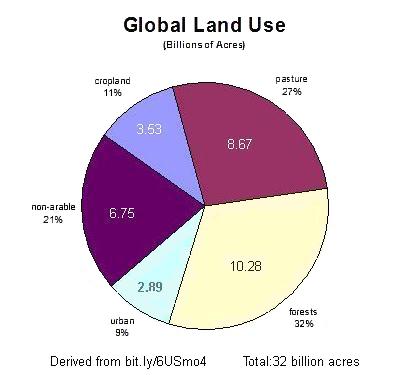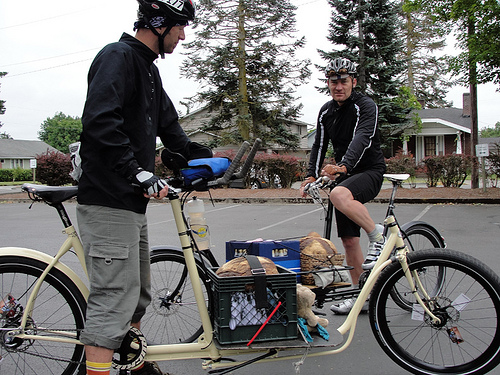WEEK 7 |
|
1. Lecture slides and notes:
Overview
- Agriculture - review of impact
- Energy, agriculture and society
- The "green revolution"
- Impacts of food production
- Transition to sustainable food economy
- Food vs. fuel
- Intro to world views
|
A. Impact
I=PAT equation
agriculture has a big impact
water - largest user
energy - 17% of all commercial energy in the US
emissions - 20% of CO2 emissions, 55% of methane
|
nexus of water, soil and energy
major portion of water budget
substantial (but not majority) portion of global energy budget
amount of land in production
image from http://foodfreedom.wordpress.com/2009/11/22/extinctions-over-population-and-the-profit-paradigm/

of which 40% is seriously degraded (wiki reading on Agriculture)
1/3 of population works in food production (ibid)
less than 5% of global aggregate GDPs (ibid)
|
B. Energy and society
progression around agriculture helped structure society
link
Types of agriculture
trade-offs between: machine capital, human labor, energy, chemical costs, and land
- low-technology farming
- smaller
- less productive
- subsistence or local market only
- intensive agriculture
- high human labor
- maybe fertilizer costs
- low to none traction
- small land use
- industrial agriculture
- low human labor
- high traction and fertilizer costs
- and machinery
- can use lower grade soil but needs lots of it
another description (Pollan)
- industrial
- industrial organic
- artisan - smaller scale
|
C. The "Green Revolution"
Brought together:
- plant genetics
- higher yield grains and rice
- less stalk more grain
- hardier for harvesting
- availability of irrigation
- use of petrochemicals
- fertilizers (N and P)
- herbicides and pesticides
- traction
benefits:
- meeting food demand for many developing countries avoiding famines
- food security
- excess food for income
disadvantages:
- moving toward fewer varieties - depleting natural range of crops
- dependence on irrigation, more severe impact when there is a drought
- dependence on energy subsidies
indirect effects of these process
- water consumption
- lake eutrophication from runoff - case study
|
D. Impacts from food choices
not in the food itself but in the embodied or life-cycle energy
people may consume more goods, but bulk food consumption stays the same
however, different foods may require more or less water or energy
- examples from last week on the embedded water in foods (water embedded in food)
- energy in foods
(about 10 * as much as nutritional)
- 68 kcal of fossil fuel energy to make 1 kcal worth of pork
- 35 kcal of fossil fuel energy to make 1 kcal worth of beef
- references - link
- high and low life cycle energy input for food can result in 5 fold difference
- animal products range over about 4 fold range, so the particular recommendation for saving energy needs to take that into account
- clams 27 MJ per portion, down to fresh cooked local cow at 3.2 MJ per portion
- 27 MJ = 6480 kCal of embodied or life-cycle energy
- link
- Ecotrust calculations show that air transported fresh salmon costs 57 times more CO2 than frozen
|
E. Transition to a sustainable and secure food system
sustainable food production
details next lecture
food security
- amount of food
- types of food available vs. nutrition
- economics
- fuel
- fertilizer
- land ownership issues
- risks in the distribution system
- sensitivity to disruption from climate
|
F. Food vs. Fuel controversy
bio-fuels are competing with food production
environmental choice, economic incentives and policies play a big role
- tax credits
- carbon incentives
- rules that require proportion of fuel to be biodiesel of ethanol
impact on land use and biodiversity
Canola plants in Oregon
|
Values and World Views - intro for next section
How do people make decisions.
World Views
World views, risk and uncertainty
|
2. In-class assessment:
|
3. Reading in the text - "Multiple Perspectives and Approaches to Complex Environmental Problems"
Chapter 11: Values and World Views
|
4. Readings from Wikipedia and Encyclopedia of Earth:
http://en.wikipedia.org/wiki/Intensive_farming
http://www.eoearth.org/article/Green_Revolution
http://en.wikipedia.org/wiki/Sustainable_agriculture
|
5. On-line activities:
Videos:
Simulations:
- Food miles calculator
- The CO2 impact per kg of food is related to the transport costs and fuel used.
- compare some foods that you like from exotic places such as coffee
- understand that air is more expensive per km but also likely to fly more km than you would use for a truck
- don't get too upset that they don't calculate the costs for cargo bikes (image and bike from a Portland bikebuilder http://www.metrofiets.com/ )

Case study or Example:
- Swedish food life cycle costs
- understand the methodology, what energy use they count and what they don't
- compare a few foods that are similar in nutrition but very different in life cycle energy costs
|
6. Learning objectives:
week 7 learning objectives
|
7. Link to the on-line assignment:
go to D2L
|
|
| |


![]()